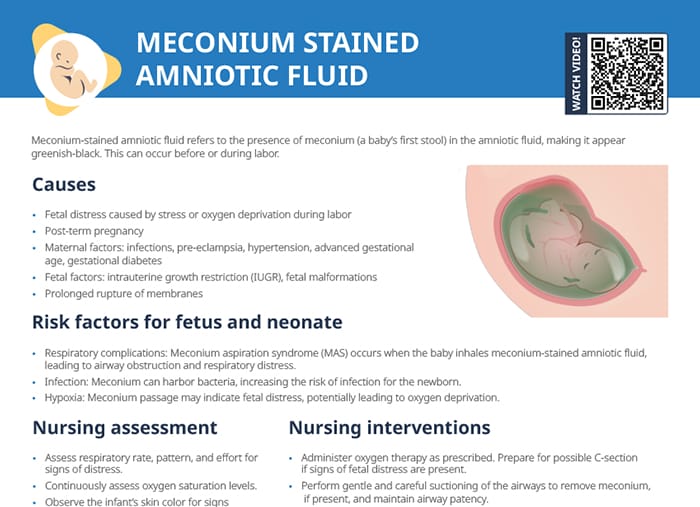What is meconium staining?
What is meconium?
Meconium is the thick, sticky first stool of a newborn.
What is amniotic fluid?
Amniotic fluid is the liquid in the uterus surrounding the fetus.
What is meconium-stained amniotic fluid?
If a fetus passes meconium before delivery, it mixes with the amniotic fluid in the uterus. The baby might inhale the meconium during labor or after delivery, which can cause serious respiratory issues (meconium aspiration syndrome, MAS).

The severity of MAS can vary with some infants only having mild breathing problems that resolve with minimal intervention, while others may require significant respiratory support.
What causes meconium staining of amniotic fluid?
Risk factors for meconium staining include:
- Breech presentation
- Post-term pregnancy
- Fetal distress
- Other maternal or fetal factors like infections, pre-eclampsia, hypertension, fetal malformations
Potential complications due to meconium staining
The bacteria in meconium can lead to infection. The baby inhaling meconium-stained amniotic fluid can lead to meconium aspiration syndrome (MAS), leading to airway obstruction and respiratory distress:
- Meconium is thick and tarry and can physically obstruct the airways.
- Meconium can irritate the airways.
- Meconium can also inactivate the lung surfactant, leading to alveoli collapsing.
Assessment and interventions
Yellowish discharge is an indication of stained amniotic fluid. When the baby is delivered, they may be covered in a yellow or greenish hue. Further assessments:
- Check respiratory rate, pattern, and effort.
- Observe for cyanosis or pallor.
- Regularly assess temperature, heart rate, and blood pressure.
- Monitor fluid intake and output.
- Stay vigilant for signs of infection.
If meconium-stained amniotic fluid is suspected, these are the steps:
- Notify NICU.
- Educate parents about the necessity to immediately assess the baby after delivery (if applicable according to the facility’s policy).
A common intervention for meconium-stained amniotic fluid was amnioinfusion, but since studies showed no improvement in respiratory issues through diluting the fluid, this is not recommended anymore.

